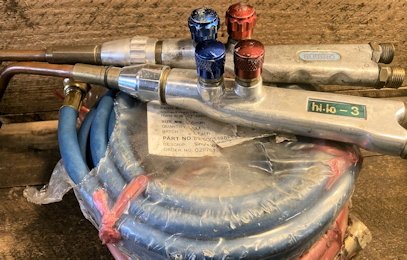Oxy-acetylene welding equipment

Here we discuss the equipment for Oxy-acetylene Welding.
High pressure oxy-acetylene welding systems consist of the following equipment
A supply of dissolved acetylene (DA) stored in steel cylinders which contain a porous substance (charcoal) and a solvent (acetone) for the gas. The cylinders are charged to a pressure of approximately 15.5 bars (221.4 psi), There are various sizes, the usual ones being 3.39 m3 and 5.66 m3.
A supply of oxygen gas in alloy steel cylinders charged to a pressure of 172.5 bars (2464.3 psi). Single cylinders of oxygen and D/A or a bank of cylinders called a manifold may be used, A manifold supplying several blowpipes usually has an acetylene safety valve and two-line pressure gauges. Copper pipe is never used for conveying acetylene because an explosion compound is formed Pressure regulators for each gas to reduce the cylinder pressure to a suitable value for welding. The regulator pressure screw should always be slackened off after welding
Rubber canvas hose with special connections. Hoses for fuel gas are red with left-handed connections, whilst the oxygen hose is blue with right-handed connections. Blowpipe with set of nozzles. The nozzle size may indicate the approximate consumption of the gas in litres/hour using a neutral flame.
Also needed, special tinted welding goggles and a spark lighter
Discharge rates of cylinders
The hourly withdrawal rate of gas an acetylene cylinder must not use greater than 20 per cent (one-fifth) of its contents. otherwise, acetone may be drawn off. The acetone
cylinder should be stood upright. Excessive withdrawal rates of oxygen, especially in cold weather. can cause icing up of regulators. Hot water should be used to thaw out frozen valves and regulators, not naked flames.
Cylinders
Oxygen cylinders are painted black and are fitted a valve outlet which has a right-hand thread. Acetylene cylinders are painted maroon and have a valve outlet a left-hand thread.
They may have a protective cover for the valve.
Regulators
Each cylinder must be fitted with the appropriate regulator which:
1 Shows the cylinder pressure.
2 Shows the pressure at the regulator outlet.
3 Enables accurate control of the output pressure using the handwheel.
4 Prevents gas from flowing back into the cylinder.
5 Prevents the gas in the cylinder from being ignited by a 'flashback'.
The regulator is set for zero output when the regulating screw is turned fully anti-clockwise, i.e., unscrewed.
Gas economizer
This consists of two valves operated by a lever. It is fitted between the regulators and the blowpipe; when the blowpipe is hung on the level, both gas supplies to the blowpipe are cut off. It is normal for a flame to be adjacent for reignition when using an economizer.
This enables:
- Saving of gas, without disturbing the valve adjustments.
- Greater safeties by ensuring that the flame is extinguished when the Pipe is not in use.
Blowpipe
This mixes the oxygen and acetylene before they are burned at the nozzle, it is fitted with control Valve to adjust the rate of flow of the gas;
This varies:
- The intensity of the flame.
- The character, i.e., oxidizing and carburizing of the flame, which is determined by the relative proportions of the two gases. Different sized nozzles may be fitted to the same blowpipe. Cutting blowpipes have a lever which when operated supplies the additional oxygen required for cutting.
Nozzles
The size of nozzle controls the size of the flame.
For heavier work, a larger nozzle is needed. The gas pressures at the regulators must be set at the
correct values for the particular nozzle in use.
Assembly of equipment
Stand both cylinders vertically either in a cylinder trolley or in cylinder stands. Cylinders should never be used lying on the floor. Ensure that jointing surfaces of cylinder valves are free from oil or grease and momentarily open, then close valves to blow out any dirt or obstructions.
Screw the appropriate regulator into each cylinder and tighten. Excessive tightening is not necessary but make certain that joints are gas-tight. The threads on oxygen cylinder valves and regulators are right-handed and on acetylene equipment left-handed.
Blow through the hoses with air to remove any dirt or dust before connecting to the regulator. Oxygen should not be used for this purpose. Connect the hoses (acetylene red, oxygen blue) to the threaded outlet of the regulator by the screwed connectors secured to the hose ends.
Check that the control valves on the blowpipe are closed and screw the appropriate size of nozzle into the blowpipe.

